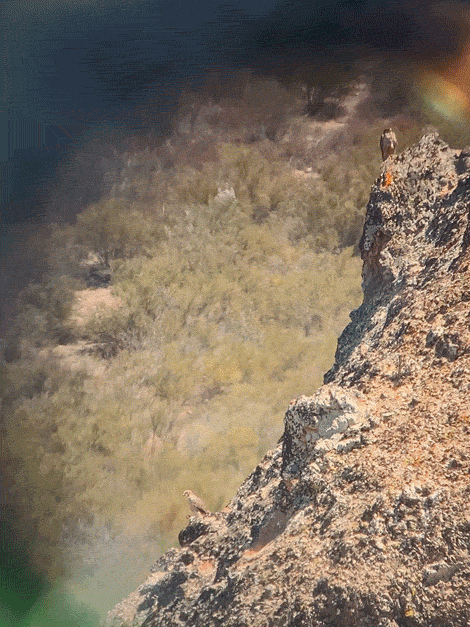Last updated: June 13, 2023
Article
Could You Take the Heat? Falcon Monitoring at Pinnacles National Park

NPS / Environment for the Americas / Jailyn Hoskins
By Mosaics in Science Intern Jailyn Hoskins, San Francisco Bay Area Network Science Communication Team
June 2022 - Driving up from Louisiana to begin my internship with the San Francisco Bay Area Network, I was warned about how hot Pinnacles National Park would be. I thought California hot and Louisiana hot had to be different and remember saying “at least I’ll be able to impress them with my heat tolerance.” Spoiler: that did not happen. The falcon monitoring work done in Pinnacles is intense, even on the “fun tour.”
When I visited, the monitoring team was made up of UC Berkeley data science interns CeeCee and Noor, Wildlife Biologist Gavin Emmons, long term volunteer Mike, and myself, the science communication intern. I woke up on the second day of my summer internship at 5:45am, cold and in a borrowed tent. We were told to be ready for 6:30 to be picked up for the hike, and all audibly sighed when Gavin showed up at 6:25.
We were going to stay on a trail then go off for a bit to see prairie and peregrine falcons. The trail started off pretty steep and I remember being so relieved when we finished. We had hiked to the Bear Gulch Reservoir, and I was excited to turn around and head downhill (so were my calves; trails in Louisiana are flat!). When I realized we were just getting started I laughed a bit. We ended up going about a mile and a half off trail. I had never gone off trail before so I had no idea what to expect. There were uphill areas made up of scraggly rocks, dense areas of chamise shrubs that tore at our clothes (and ripped my pants in the back, haha), and a western rattlesnake that Gavin was so calm about.
Once we got to our first viewing spot we set up scopes and got to see how the data collection is done. A notebook and a pen—classic. At this point in the hike the temperature was about 90 degrees. I forgot to wear a hat so I was feeling how brutal the sun could be. Gavin and Mike pointed out the nests to us and we were able to observe both the peregrine and prairie falcon fledglings they had been monitoring. There’s no way I would have been able to spot them on my own. We had hiked a lot, but were miles away from the nest. I didn’t realize how far away we would be from the birds. Once the nests were in the spotting scopes I could still hardly make out what we were looking at. Being at this distance allowed for us to safely monitor without stressing out the birds.

NPS / Environment for the Americas / Jailyn Hoskins

NPS / Environment for the Americas / Jailyn Hoskins
The hike was very educational. Gavin explained how Pinnacles offers a lot of suitable habitat for nesting falcons, as they enjoy the cliffs the area has to offer. We learned the backstory on the raptor advisories and monitoring program put in place to ensure their population health. There’s a lot of work that goes into tracking Pinnacles’ falcon populations, and it is completed by a small team dedicated to working with these species. There are people out in the field everyday going back to the same monitoring sites to check for the progress of these nests and meticulously documenting what they see. I was proud of the program just hearing about the monitoring efforts over the years.
After four hours of hiking and data collection we headed back down. A normal day would have included several more hours in the blistering sun. I thought that the 64oz of water I brought was overkill and realized how much I had consumed on the way up. Walking down I actually ran out of water and Gavin, who I had only seen stop for a few sips, graciously poured me some from his water bottle. I silently shed a tear as I saw the ice cubes fall into my water bottle. I was not used to the dry heat (having been born into humidity) and felt like my thirst was unquenchable.
I learned a lot about myself on this hike too. I learned to always bring more water and snacks than I think I will need, to not try to keep up with the daily hiker, and that I much prefer the downhill trail portions. Oh, and that the California heat has my respect!
For more information
- Pinnacles Raptor Advisories and Raptors webpages
- San Francisco Bay Area Network Falcon Monitoring webpage
- Pacific Coast Science & Learning Center Prairie & Peregrine Falcons webpage
- Contact Wildlife Biologist Gavin Emmons
See more from the Bay Area Nature & Science Blog
